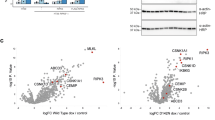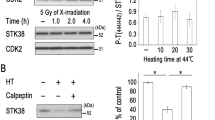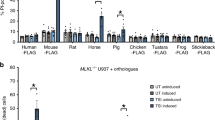Abstract
We have cloned a member of the STE20/SPS1 protein kinase family from a transformed rat pancreatic beta cell line. SPAK (STE20/SPS1-related, proline alanine-rich kinase) belongs to the SPS1 subfamily of STE20 kinases and is highly conserved between species. SPAK is expressed ubiquitously, although preferentially in brain and pancreas. Biochemical characterization of SPAK catalytic activity demonstrates that is a serine/threonine kinase that can phosphorylate itself and an exogenous substrate in vitro. SPAK is immunoprecipitated from transfected mammalian cells as a complex with another, as yet uncharacterized, serine/threonine kinase which is capable of phosphorylating catalytically-inactive SPAK and myelin basic protein in an in vitro kinase assay. SPAK specifically activates the p38 pathway in cotransfection assays. Like MST1 and MST2, SPAK contains a putative caspase cleavage site at the junction of the catalytic domain and the C-terminal region. Full-length SPAK is expressed in the cytoplasm in transfected cells, while a mutant corresponding to caspase-cleaved SPAK is expressed predominantly in the nucleus. The similarity of SPAK to other SPS1 family members, its ability to activate the p38 pathway, in addition to its putative caspase cleavage site, provide evidence that SPAK may act as a novel mediator of stress-activated signals.
This is a preview of subscription content, access via your institution
Access options
Subscribe to this journal
Receive 50 print issues and online access
$259.00 per year
only $5.18 per issue
Buy this article
- Purchase on Springer Link
- Instant access to full article PDF
Prices may be subject to local taxes which are calculated during checkout







Similar content being viewed by others
Abbreviations
- MAP kinase:
-
mitogen activated protein kinase
- ERK:
-
extracellular signal-regulated kinase
- JNK:
-
c-Jun N terminal kinase
- MAPKK:
-
mitogen activated protein kinase kinase
- MAPKKK:
-
mitogen activated protein kinase kinase kinase
- PAK:
-
p21-activated kinase
- GCK:
-
germinal center kinase
- GCKR:
-
germinal center kinase-related
- GLK:
-
GCK-like kinase
- HPK1:
-
hematopoietic progenitor kinase 1
- NIK:
-
NCK-interacting kinase
- SOK-1:
-
STE20/ oxidant stress responsive kinase-1
- MST:
-
mammalian sterile 20-like
- LOK:
-
lymphocyte oriented kinase
- SPAK:
-
STE20/SPS1-related proline alanine-rich kinase
- RIN:
-
rat insulinoma
- BLAST:
-
basic local alignment search tool
- GFP:
-
green fluorescent protein
- PCR:
-
polymerase chain reaction
- GST:
-
glutathione S-transferase
- HA:
-
hemagglutinin
- FCS:
-
fetal calf serum
- IPTG:
-
isopropyl-B-D-thiogalactoside
- DTT:
-
dithiothreitol
- PMSF:
-
phenylmethylsulfonyl fluoride
- MBP:
-
myelin basic protein
- HRP:
-
horseradish peroxidase
- TBS:
-
tris-buffered saline
- PVDF:
-
polyvinylidene difluoride
References
Boulikas T. . 1993 Crit. Rev. Euk. Gene. Exp. 3: 193–227.
Brown JL, Stowers L, Baer M, Trejo J, Coughlin S and Chant J. . 1996 Curr. Biol. 6: 598–605.
Cahill MA, Peter ME, Kischkel FC, Chinnaiyan AM, Dixit VM, Krammer PH and Nordheim A. . 1996 Oncogene 13: 2087–2096.
Creasy CL and Chernoff J. . 1995a J. Biol. Chem. 270: 21695–21700.
Creasy CL and Chernoff J. . 1995b Gene. 167: 303–306.
DeAizpurua HJ, Cram DS, Naselli G, Devereux L and Dorow DS. . 1997 J. Biol. Chem. 272: 16364–16373.
Diener K, Wang XS, Chen C, Meyer CF, Keesler G, Zukowski M, Tan TH and Yao Z. . 1997 Proc. Natl. Acad. Sci. USA 94: 9687–9692.
Eichinger L, Bahler M, Dietz M, Eckerskorn C and Schleicher M. . 1998 J. Biol. Chem. 273: 12952–12959.
Frank G and Weeds AG. . 1974 Eur. J. Biochem. 44: 317–334.
Friesen H, Lunz R, Doyle S and Segall J. . 1994 Genes Dev. 8: 2162–2175.
Graves JD, Draves KE, Craxton A, Saklatvala J, Krebs EG and Clark EA. . 1996 Proc. Natl. Acad. Sci. USA 93: 13814–13818.
Graves JD, Gotoh Y, Draves KE, Ambrose D, Han DK, Wright M, Chernoff J, Clark EA and Krebs EG. . 1998 EMBO J. 17: 2224–2234.
Hejtmancik JF, Thompson MA, Wistow G and Piatigorsky J. . 1986 J. Biol. Chem. 261: 982–987.
Hu MC, Qiu WR, Wang X, Meyer CF and Tan TH. . 1996 Genes. Dev. 10: 2251–2264.
Juo P, Kuo CJ, Reynolds SE, Konz RF, Raingeaud J, Davis RJ, Biemann HP and Blenis J. . 1997 Mol. Cell. Biol. 17: 24–35.
Katz P, Whalen G and Kehrl JH. . 1994 J. Biol. Chem. 269: 16802–16809.
Kiefer F, Tibbles LA, Anafi M, Janssen A, Zanke BW, Lassam N, Pawson T, Woodgett JR and Iscove NN. . 1996 EMBO J. 15: 7013–7025.
Kuramochi S, Moriguchi T, Kuida K, Endo J, Semba K, Nishida E and Karasuyama H. . 1997 J. Biol. Chem. 272: 22679–22684.
Kyriakis JM. . 1999 J. Biol. Chem. 274: 5259–5262.
Leberer E, Dignard D, Harcus D, Thomas DY and Whiteway M. . 1992 EMBO J. 11: 4815–4824.
Lee KK, Murakawa M, Nishida E, Tsubuki S, Kawashima S, Sakamaki K and Yonehara S. . 1998 Oncogene 16: 3029–3037.
Lee MH, Reynisdottir I and Massague J. . 1995 Genes Dev. 9: 639–649.
Masson D and Kreis TE. . 1993 J. Cell. Biol. 123: 357–371.
Nagata S. . 1997 Cell. 88: 355–365.
Pombo CM, Bonventre JV, Molnar A, Kyriakis J and Force T. . 1996 EMBO J. 15: 4537–4546.
Ramer SW and Davis RW. . 1993 Proc. Natl. Acad. Sci. USA 90: 452–456.
Robinson MJ and Cobb MH. . 1997 Curr. Opin. Cell Biol. 9: 180–186.
Schinkmann K and Blenis J. . 1997 J. Biol. Chem. 272: 28695–28703.
Shi CS and Kehrl JH. . 1997 J. Biol. Chem. 272: 32102–32107.
Su YC, Han J, Xu S, Cobb M and Skolnik EY. . 1997 EMBO J. 16: 1279–1290.
Taylor LK, Wang HC and Erikson RL. . 1996 Proc. Natl. Acad. Sci. USA 93: 10099–10104.
Ushiro H, Tsutsumi T, Suzuki K, Kayahara T and Nakano K. . 1998 Arch. Biochem. Biophys. 355: 233–240.
Williamson MP. . 1994 Biochem. J. 297: 249–260.
Wilson DJ, Fortner KA, Lynch DH, Mattingly RR, Macara IG, Posada JA and Budd RC. . 1996 Eur. J. Immunol. 26: 989–994.
Xia Z, Dickens M, Raingeaud J, Davis RJ and Greenberg ME. . 1995 Science 270: 1326–1331.
Zhou G, Bao ZQ and Dixon JE. . 1995 J. Biol. Chem. 270: 12665–12669.
Acknowledgements
We thank Dr Donna Dorow for helpful discussions and for providing the epitope-tagged MAPK and pGEX–c-Jun expression constructs, Dr Steve Gerondakis for providing 12CA5 anti-HA antibodies and Helen Thomas for critical reading of the manuscript. This work was supported by The Angelo and Susan Alberti Program Grant from the Juvenile Diabetes Foundation.
The nucleotide sequences reported in this paper have been submitted to the GenBankTM/EBI Data Bank with accession numbers AF099988, AF099990 and AF099989 for mouse, rat and human SPAK, respectively.
Author information
Authors and Affiliations
Rights and permissions
About this article
Cite this article
Johnston, A., Naselli, G., Gonez, L. et al. SPAK, a STE20/SPS1-related kinase that activates the p38 pathway. Oncogene 19, 4290–4297 (2000). https://doi.org/10.1038/sj.onc.1203784
Received:
Revised:
Accepted:
Published:
Issue Date:
DOI: https://doi.org/10.1038/sj.onc.1203784
Keywords
This article is cited by
-
GWAS identifies candidate susceptibility loci and microRNA biomarkers for acute encephalopathy with biphasic seizures and late reduced diffusion
Scientific Reports (2022)
-
SPAK-p38 MAPK signal pathway modulates claudin-18 and barrier function of alveolar epithelium after hyperoxic exposure
BMC Pulmonary Medicine (2021)
-
Osmotic stress induces the phosphorylation of WNK4 Ser575 via the p38MAPK-MK pathway
Scientific Reports (2016)
-
c-Abl–p38α signaling plays an important role in MPTP-induced neuronal death
Cell Death & Differentiation (2016)
-
Association of three candidate genetic variants in RAB7L1/NUCKS1, MCCC1 and STK39 with sporadic Parkinson’s disease in Han Chinese
Journal of Neural Transmission (2016)



